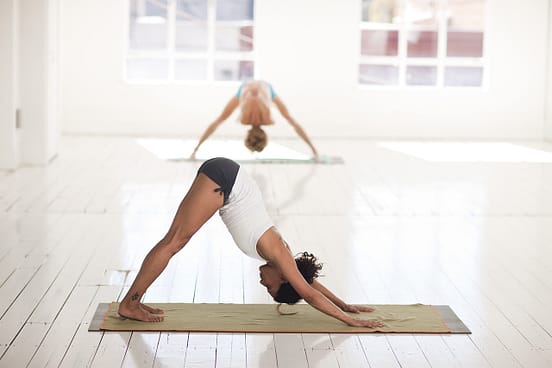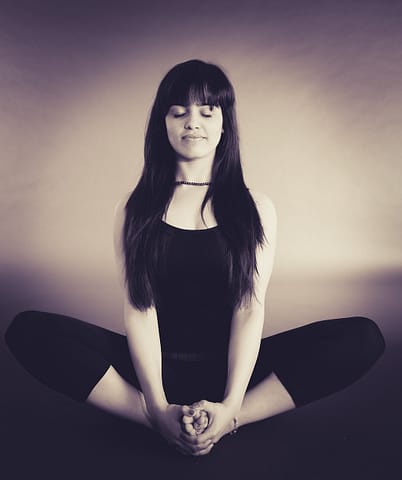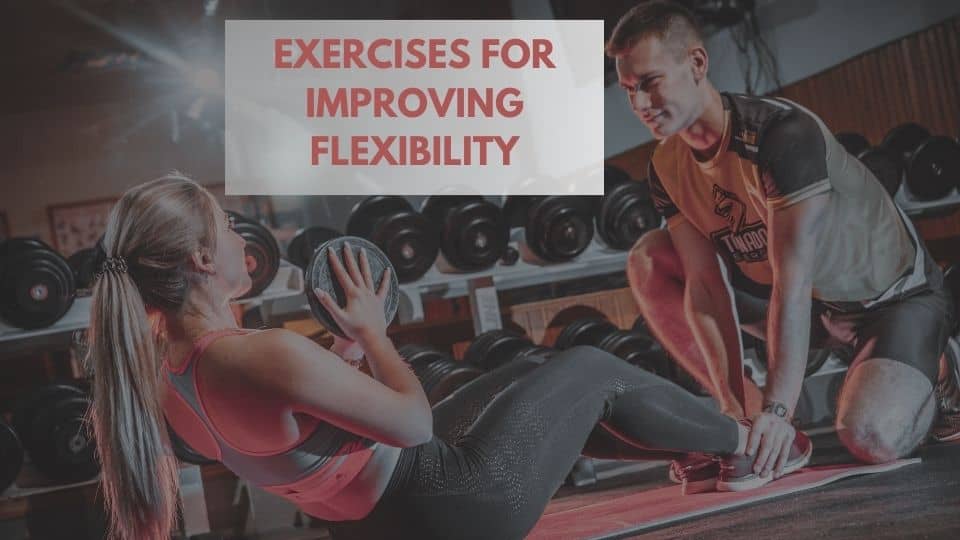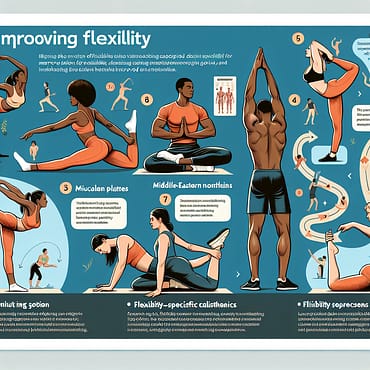Are you looking to improve your flexibility but not sure where to start? Look no further! In this article, we will explore the best exercises that can help you become more flexible. Whether you are a seasoned athlete or just starting out on your fitness journey, incorporating these exercises into your routine can help you achieve your flexibility goals. So grab your yoga mat and get ready to stretch your way to a more limber and supple body!
Stretching Exercises
Stretching exercises are a fantastic way to improve flexibility and enhance your overall physical performance. Whether you’re an athlete looking to improve your range of motion or simply someone who wants to become more flexible, incorporating stretching exercises into your routine can bring numerous benefits. There are different types of stretching exercises that target different muscle groups and involve varying levels of intensity. Let’s take a closer look at some of the most effective stretching exercises that can help you achieve your flexibility goals.
Static Stretching
Static stretching involves holding a specific stretch for a prolonged period, typically around 15-30 seconds. It focuses on lengthening and relaxing the muscles, allowing for increased flexibility over time. Static stretches are most beneficial when performed after a workout, as they help to cool down the muscles and prevent tightness and soreness. Some popular static stretching exercises include stretching the hamstrings, quadriceps, and calves.
Dynamic Stretching
Dynamic stretching involves moving through a full range of motion to warm up and prepare the body for physical activity. It helps improve flexibility, mobility, and muscle activation. Unlike static stretching, dynamic stretches are typically performed in a more fluid and controlled manner. Examples of dynamic stretching exercises include walking lunges, arm circles, and leg swings. These exercises are especially valuable before a workout or any strenuous physical activity as they help increase blood flow and prepare the body for action.
Ballistic Stretching
Ballistic stretching involves using repetitive bouncing movements to stretch the muscles. While it can help improve flexibility, it requires caution as it can potentially cause injury, especially if done incorrectly or without adequate warm-up. Ballistic stretching is often seen in sports-specific movements and is more common among athletes who need explosive power and agility. Examples of ballistic stretching exercises include bouncing lunges and arm swings.
Stretching exercises are like a warm-up routine before the workout, use an sets the baseline for fitness levels.
Yoga Poses
Yoga not only promotes mental well-being but also offers incredible physical benefits, including increased flexibility. The practice of yoga involves a combination of asanas (poses) that integrate flexibility, strength, and balance. Here are three yoga poses that can greatly contribute to improving your flexibility.
Downward-Facing Dog
Downward-Facing Dog (Adho Mukha Svanasana) is one of the most recognizable yoga poses and is highly effective for stretching multiple muscle groups. It primarily targets the hamstrings, calves, and shoulders. In this pose, you begin on your hands and knees, then lift your hips upward, forming an inverted V shape with your body. Downward-Facing Dog not only stretches tight muscles but also strengthens the arms and shoulders, making it a well-rounded pose.
Child’s Pose
Child’s Pose (Balasana) is a gentle stretch that provides a deep release for the lower back, hips, and thighs. It is a relaxing and restorative pose that helps calm the mind and is often used as a resting position between more challenging poses. To practice Child’s Pose, you kneel on the floor, fold forward, and rest your forehead on the ground while keeping your arms extended or relaxed by your sides. This pose allows for a gentle stretch and promotes relaxation and flexibility.
Bridge Pose
Bridge Pose (Setu Bandhasana) is an excellent pose for stretching the chest, shoulders, spine, and hips. It strengthens the back, glutes, and legs while simultaneously improving flexibility. To perform this pose, lie on your back, bend your knees, and lift your hips upward while keeping your feet and palms grounded. Bridge Pose helps open the chest and shoulders while stimulating the abdominal organs, making it a beneficial pose for both flexibility and core strength.

This image is property of pixabay.com.
Pilates Exercises
Pilates is renowned for its focus on core strength, stability, and flexibility. While its primary emphasis is on developing core muscles, Pilates exercises also provide an opportunity to enhance flexibility in various parts of the body. Here are three Pilates exercises that can help improve your overall flexibility.
Leg Circles
Leg Circles is a Pilates exercise that targets the hip flexors, glutes, and outer thighs while promoting flexibility in the leg muscles. To perform this exercise, lie on your back, lift one leg toward the ceiling, and draw circles in the air with your foot, keeping your leg straight. This exercise engages the core, strengthens the hip muscles, and increases range of motion in the hip joint.
Roll-Up
The Roll-Up is a classic Pilates exercise that primarily works the abdominal muscles but also requires flexibility in the back and hamstrings. To execute this exercise, lie on your back, reach your arms overhead, and roll up to a seated position while keeping your legs straight and your feet flexed. The Roll-Up helps stretch the spine and improves flexibility in the back, hamstrings, and hip flexors.
Spine Stretch Forward
The Spine Stretch Forward exercise stretches the back and hamstrings while targeting core strength and flexibility. Sitting on the floor with your legs extended in front of you, you inhale and gradually roll your spine forward, reaching toward your feet. This exercise improves spinal mobility, stretches the back, and enhances hamstring flexibility.
Tai Chi Moves
Tai Chi is an ancient Chinese martial art that combines graceful movements, deep breathing, and meditation. It is known for its numerous health benefits, including increased flexibility, balance, and relaxation. While Tai Chi forms and sequences are vast, here are three fundamental moves that can help enhance flexibility.
Lift Hands
Lift Hands is a foundational Tai Chi move that involves raising and lowering the arms while maintaining soft and relaxed movements. This exercise promotes shoulder mobility, stretches the upper body muscles, and improves overall flexibility. Incorporating Lift Hands into your Tai Chi practice can gradually increase range of motion and flexibility in the arms and shoulders.
Grasp Sparrow’s Tail
Grasp Sparrow’s Tail is a continuous movement in Tai Chi that includes various techniques to push, ward off, roll back, and press. This sequence involves gentle flowing motions that help improve overall body flexibility, particularly in the upper body and hips. Grasp Sparrow’s Tail also promotes coordination, balance, and mindfulness.
Snake Creeps Down
Snake Creeps Down is a Tai Chi movement that targets the lower body, particularly the hips, hamstrings, and calves. It involves lunging movements and elongation of the legs to enhance flexibility in the lower body. Snake Creeps Down also improves balance and stability while promoting relaxation and mindful transitions.

This image is property of pixabay.com.
Also Check: What Are The Benefits Of Practicing Meditation?
Dance Techniques
Dance is an art form that requires strength, precision, and flexibility. Dancers often showcase incredible range of motion and impressive moves that are a result of dedicated training and consistent stretching. Here are three dance techniques that can help improve your flexibility.
Splits
Splits are a quintessential dance technique that require flexibility in the hamstrings, hips, and inner thighs. By gradually working on the splits, you can increase your range of motion and improve hip flexibility. There are different variations of splits, including front splits and side splits, which target different muscle groups. Practicing splits regularly, with the guidance of a dance instructor or stretching coach, can lead to significant improvement in flexibility over time.
Fouetté Turn
The Fouetté Turn is a classical ballet technique that involves a speedy series of pirouettes with a whipping leg motion. To execute this turn, dancers need a combination of balance, coordination, and core strength, along with flexible hip flexors and hamstrings. Regular stretching and targeted exercises can enhance the necessary flexibility to execute the Fouetté Turn with grace and precision.
Grand Battement
The Grand Battement is a dynamic movement in ballet that requires flexibility and strength in the hip, leg, and core muscles. It involves kicking one leg straight up in the air while maintaining proper alignment and control. Regular practice of the Grand Battement, along with specific stretches targeting the hip flexors, hamstrings, and quadriceps, can lead to increased range of motion and improved leg flexibility.
Resistance Band Exercises
Resistance band exercises provide a unique way to incorporate resistance training into your flexibility routine. The use of resistance bands can increase the effectiveness of stretching exercises while also promoting muscle activation and strength. Here are three resistance band exercises that can help improve flexibility.
Seated Forward Bend
The Seated Forward Bend, also known as Paschimottanasana, is a seated stretch that targets the hamstrings, lower back, and calf muscles. When incorporating a resistance band into this stretch, you can enhance the intensity and deepen the stretch. By securing the band around your feet and gently pulling yourself forward, you can effectively increase flexibility in the hamstrings and back while activating the core muscles.
Shoulder Stretch
The Shoulder Stretch with a resistance band is an excellent exercise for improving shoulder flexibility and mobility. By holding the band with both hands and extending your arms overhead, you can gently pull the band apart, stretching the shoulders and opening the chest. This exercise helps alleviate tension in the shoulder area and improves overall flexibility in the upper body.
Hamstring Stretch
The Hamstring Stretch with a resistance band is a valuable exercise for targeting the hamstrings and improving flexibility in the back of the thighs. To perform this exercise, secure the band around your foot and extend your leg in front of you while keeping it straight. Gently pull back on the band to deepen the stretch. This exercise helps lengthen the hamstrings and can lead to increased flexibility and range of motion over time.
Source: TheTechBrain Ai
Foam Rolling Techniques
Foam rolling, also known as self-myofascial release, is a popular technique used to enhance flexibility, relieve muscle tension, and improve overall mobility. It involves using a foam roller to apply pressure to specific muscles and soft tissues, promoting relaxation and alleviating tightness. Here are three foam rolling techniques that can benefit your flexibility routine.
Quadriceps Roll
The Quadriceps Roll targets the quadriceps muscles at the front of the thighs. By placing the foam roller under your thighs, you can use your body weight to roll up and down, massaging and stretching the muscles. This technique helps release tension in the quads, improves flexibility, and supports recovery after strenuous activities.
Calf Roll
The Calf Roll targets the calf muscles, which can often become tight due to prolonged standing, running, or wearing high-heeled shoes. By positioning the foam roller under your calves and rolling from the ankles to the knees, you can increase blood flow, stretch the calves, and enhance flexibility. Incorporating calf rolling into your routine can help prevent injuries and promote overall lower leg mobility.
Upper Back Roll
The Upper Back Roll focuses on releasing tension in the upper back, shoulders, and neck. By lying on the foam roller with your spine aligned vertically along the roller, you can gently roll back and forth, targeting the muscles along the spine. This technique helps improve flexibility, relieve tightness, and promote better posture.
Gymnastics Drills
Gymnastics is a sport that requires strength, flexibility, and precision. Gymnasts undergo rigorous training to achieve exceptional flexibility, which allows them to perform gravity-defying movements with ease. Here are three gymnastics drills that can contribute to improving flexibility.
Pike Stretch
The Pike Stretch is a foundational gymnastics drill that focuses on stretching the hamstrings and lower back. By sitting on the floor with your legs extended in front of you, you reach forward and aim to touch your toes. The Pike Stretch helps lengthen the hamstrings, increase flexibility in the lower back, and develop core strength. Regular practice of this drill can lead to significant improvements in overall flexibility.
Bridge Kickover
The Bridge Kickover is an advanced gymnastics skill that requires flexibility in the back, shoulders, and hips. It involves transitioning from a backbend (bridge) position to a standing position, kicking over, and extending the legs. Regular stretching and conditioning exercises targeting the back, shoulders, and hip flexors can help enhance the necessary flexibility and strength to perform the Bridge Kickover safely and effectively.
Straddle Stretch
The Straddle Stretch is a vital component of gymnastics training, as it targets the adductor muscles in the inner thighs, hips, and lower back. To perform the Straddle Stretch, you sit on the floor and extend your legs out to the sides, forming a 180-degree angle. This drill encourages flexibility in the hips and inner thigh muscles, allowing gymnasts to achieve wide straddle positions and execute various skills with ease.
Martial Arts Stretches
Martial arts, such as karate, taekwondo, and kung fu, require a combination of strength, agility, and flexibility. Flexibility is particularly important for high kicks, splits, and fluid movements. Here are three martial arts stretches that can help improve your flexibility.
Butterfly Stretch
The Butterfly Stretch is a fundamental stretch that targets the hips, inner thighs, and lower back. It involves sitting on the floor with the soles of your feet together while gently pressing your knees toward the ground. This stretch helps open the hips, lengthen the adductor muscles, and increase flexibility for kicking techniques in martial arts.
Side Split Stretch
The Side Split Stretch, also known as the straddle split, focuses on increasing flexibility in the inner thighs, hips, and hamstrings. It involves splitting the legs apart as wide as possible while keeping the toes pointed forward. This stretch is essential for achieving high kicks and performing techniques that require a wide range of motion, making it highly beneficial for martial arts practitioners.
Front Split Stretch
The Front Split Stretch targets the hamstrings, hip flexors, and groin muscles. It involves extending one leg forward and the other leg backward, creating a straight line between the legs. The Front Split Stretch helps develop flexibility for kicking techniques and improves overall lower body mobility. Gradual and consistent practice can lead to impressive improvements in flexibility.
Swimming Drills
Swimming is a low-impact, full-body workout that engages multiple muscle groups while providing cardiovascular benefits. Incorporating swimming drills into your exercise routine not only improves cardiovascular endurance but also enhances flexibility in the upper body. Here are three swimming drills that can increase your overall flexibility.
Kickboard Kicks
Kickboard Kicks involve using a kickboard to focus on lower body strength and flexibility. By holding onto a kickboard with your arms extended, you kick your legs vigorously, engaging the quadriceps, hamstrings, and glute muscles. This drill helps increase leg flexibility, promotes ankle flexibility, and improves overall lower body strength.
Torpedo Drill
The Torpedo Drill is a swimming drill that emphasizes full-body engagement and flexibility. It involves floating on your back with your arms overhead and your legs extended. By using a flutter kick, you imitate the motion of a torpedo moving through the water. The Torpedo Drill improves core stability, enhances hip flexibility, and promotes fluid movements in the water.
Backstroke Arm Reach
The Backstroke Arm Reach drill targets the shoulders, upper back, and shoulder blades. It involves lying on your back in the water while focusing on the arm movements used during backstroke swimming. By reaching forward and backward with one arm at a time, you engage the shoulder muscles and work on shoulder flexibility. Incorporating this drill into your swimming routine can help improve mobility and strength in the upper body.
Incorporating stretching exercises, yoga poses, Pilates exercises, tai chi moves, dance techniques, and swimming drills can greatly enhance flexibility. Remember to start slowly and gradually increase the intensity and duration of your stretching routine over time. By regularly engaging in these exercises and techniques, you can unlock your body’s full potential and experience the numerous benefits of improved flexibility. So get ready to stretch, strengthen, and become more limber. Your body will thank you for it!






